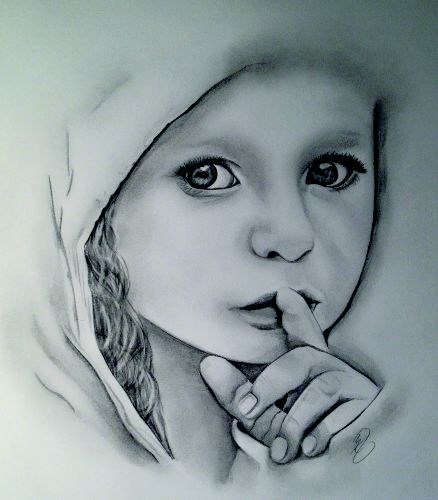Erin Filan's sketches are dark. Sometimes, that just means the pencil has cut blacker lines and thicker coatings on the paper. Sometimes it also means the moods and tones go into cloudier emotional atmospheres.
Filan uses her art partially as a way to express her own feelings, and partially to tell silent stories. More than 30 of these monochromatic narratives will be unveiled next week at the Two Rivers Gallery. The curatorial staff there were as captivated by the depth of these sketches as the casual viewer.
"What we humans do is judge each other. And we all put on that persona when we go to work that says 'I don't hurt.' All of us do that, and none of us, or very few of us, ever break that facade," said Filan, who has a white collar job in a downtown financial institution by day, then pours out these shaded emotions onto paper at night. "What we don't do enough of is, when we see someone acting out negative behaviours and making bad emotional decisions, consider the motives behind that behaviour. We don't like to show ours and we don't like to understand others. That is why I called this show From The Outside In - for two reasons."
The title touches on looking deeper into human conditions and thinking past people's surfaces, but it also refers to her unique artistic technique of keying on a couple of main initial features like an eye or a mouth and building the intense detail in her drawings in from those vague singular starting points. It is more common for artists to design each work on a grid, do all the base figuring in that way, then paint over it with the details until the grid is no longer discernible. Filan sees the entire image in her imagination, and sets about producing it as a whole drawing as if her pencil was a camera shooting the pictures in her head.
Regardless of the mood - laughing babies, proud fishers holding their catch, the victim of abuse - each face has a story to it and most of it is told through the eyes. Filan invests her greatest efforts in the eyes of her subjects.
Filan said often there are direct elements of truth to that unspoken backstory, but often it is just something she has imagined. Like a novelist typing out rich fiction, she is trying to talk about the human condition - lay an artistic hand on the shoulder of common experience.
"It's the unspoken word of what we are all going through, or what we all think about even if we don't say it out loud," she said.
Her work has become coveted by people wishing for portraits, tattoo customers looking for designs before putting needle to skin, charitable organizations wishing for a donation (she is intensely selective) or businesses looking for custom original images for their commercial space.
Her most ambitious image so far took Filan about 136 hours. Many of them are time commitments of 50 hours or more. She keeps track because this is not a hobby.
"I have set my art up as a business and I run it as a business," she said.
The part that might rankle a frustrated aspiring artist is her level of instruction. She took high school art and dropped it when she graduated more than 10 years ago. On a whim about three years ago she got the bug to draw a picture, and these lifelike faces fell off the end of her pencil almost effortlessly.
Well, the understanding of how to slice the tools over the skin of the paper was effortless. The actual work is far from effortless.
"I have my kids part-time in a shared custody arrangement, so on the nights I have the kids I'll start work after they are in bed and I'll go until midnight-one in the morning. On the nights the kids are not with me, I'll start at maybe six o'clock and go to midnight-one in the morning."
She intellectually knows that she has rare art skills, but she also struggles with a common condition among artists of every genre: the dreaded second-thought. Even after 50 hours on an image she will suddenly start to dislike what she sees and want to discard it. Part of her journey to professionalism, she said, is keeping perspective, seeking out fresh eyes to help her through an image in progress, and listening to friends when they encourage her to finish a piece she has stalled on.
That circle of influence might well grow after she shows the city 30 of her latest works all on display in the Two Rivers Gallery's Rustad Galleria starting on June 11. A reception will be held at 7:30 p.m. with Filan on hand to talk about the images and answer the public's questions about her process.



